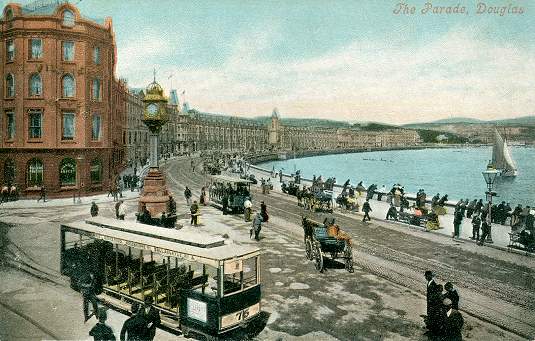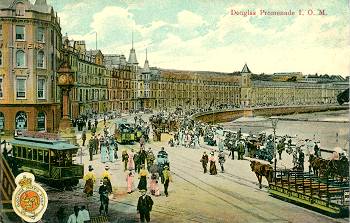

This postcard shows Loch Promanade in Douglas, Isle of Man, being published by J.Valentine of Dundee about 1904, the date when our copy was posted from Douglas to Trowbridge in Wiltshire. It shows crossbench car 75 of the Upper Douglas cable tramway, built by G.F.Milnes & Co. Ltd. of Birkenhead in 1896. The small view (below) at the same location is postcard no. 1890 in the Milton "Glazette" series, published in London by Woolstone Brothers around 1905. Our copy was posted in 1908 from Douglas to Ashton-under-Lyne, Lancashire. Note the Isle of Man three-legged crest. On the left of the scene is saloon car 82 of the cable tramway, also built by Milnes in 1896. In the centre is crossbench horse tram 32, which again was built by Milnes in 1896. On the right is a toastrack horse tram of a type built by Milnes between 1884 and 1891, and is carrying the advertising "To and from the Manx Electric Railway". At the date of these postcards all these trams were operated by Douglas Corporation.
As a result of the efforts of Thomas Lightfoot, the Douglas Bay Tramway opened on 7th August 1876. Initially this 3ft gauge single track horse tramway ran between Burnt Mill Hill (now called Summer Hill) and the Iron Pier (which was demolished in 1894), being extended in January 1877 south to Victoria Pier. In 1882 Lightfoot sold his line to the Isle of Man Tramways Company who extended northwards to Derby Castle and built a depot there in 1886 and doubled the track, bringing the length of the line to 1¾ miles. In 1894 the company was taken over by the coastal electric tramway, by then the Isle of Man Tramways & Electric Power Co., who had thoughts of electrification, opposed by Douglas Corporation. Following a financial scandal this company went into receivership, and in 1901 the horse tramway was sold to Douglas Corporation who have worked it since, summertime only after 1927.
 The horse tramway had a mixture of rolling stock. The early cars were double-deck but subsequent trams were single deck, some enclosed saloons but mostly open toastracks, with or without a roof. The current running fleet is around 20 trams, others being stored or preserved. There is still one double-decker running, restored in 1989 from being converted to single deck in 1903, and a second is in the Manx Museum. The livery is mostly red and ivory, but a few cars are blue and ivory.
The horse tramway had a mixture of rolling stock. The early cars were double-deck but subsequent trams were single deck, some enclosed saloons but mostly open toastracks, with or without a roof. The current running fleet is around 20 trams, others being stored or preserved. There is still one double-decker running, restored in 1989 from being converted to single deck in 1903, and a second is in the Manx Museum. The livery is mostly red and ivory, but a few cars are blue and ivory.
Considering the route too steep for other forms of traction, on 15th August 1896 the Isle of Man Tramways & Electric Power Co. opened the Upper Douglas Tramway using cable haulage. The line was built by Dick Kerr & Co. who had previously installed the Streatham Hill line in London. It was to 3ft gauge and was 1½ miles in length, mostly double track. From the junction with the horse tramway as shown in our postcard, the route was up Victoria Street and Prospect Hill, along Buck's Road and Woodbourne Road, and then down Ballaquayle Road and Broadway where it ended adjacent to the horse tramway. The depot and winding house were at the junction of what is now called York Road and Ballaquayle Road. There were two high-pressure non-condensing steam engines, each being 250 horsepower with cylinders of 20in bore and 42in stroke.
Rolling stock was 16 single-deck trams consisting of ten 38-seat crossbench cars, two 38-seat combination cars (converted from crossbench cars) and four 32-seat saloon cars. They were numbered 67-82, a range above that of the horse trams (highest number 50). There was a continuously moving cable in a conduit below the centre of the tracks, which was engaged by a gripper on the tram when the driver turned a handwheel. The tram livery has been stated as red or teak and ivory white, but on restoration of the surviving car a deep blue was found.
On the collapse of the Isle of Man Tramways & Electric Power Co. in 1901, the cable tramway shared the same fate as the horse trams, being taken over by Douglas Corporation for the sum of £50,000 for both systems. By the 1920s urgent need of expensive maintenance was needed, so from 1921 Corporation buses ran the winter service. The cable trams system closed on 19th August 1929.
Today in the summer you can still ride on a Douglas horse car along the seafront, although the service is now very limited and it is clearly just a tourist ride rather than a serious form of public transport. One cable car, restored from parts of cars 72 and 73, can be seen at the horse tram depot at the north end of the promenade. From the same location you are conveniently placed to take a ride on the Manx Electric Railway (see Postcard).
![]() Go to Postcard Of The Month Index
Go to Postcard Of The Month Index